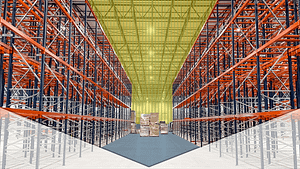Relocating to a new warehouse is a logistical challenge for small and medium companies operating 3PL or other warehousing services. Moving facilities while keeping the flow of normal day-to-day business requires a well-drawn-out and thoroughly thought-through plan. So what does it take to execute a move smoothly? Nautical Manufacturing & Fulfillment, having just finished its own warehouse move op, has in-house experts willing to share relocation insights to help make a move as painless as possible. Read on for their tips.
When Should Warehousing Companies Relocate?
Deciding whether to relocate a warehouse is a strategic decision for a business. Moving too early can lead to unnecessary costs but moving too late can end up causing lost opportunities and revenue. All contractual commitments must also be upheld during the move execution, which can complicate. Prior to planning for a warehouse move, your business should consider the following questions.
What is your current warehouse capacity?
Your warehouse’s occupancy rate is an essential factor when it comes to the urgency of expanding your facilities overhead. The maximum occupancy rate should stay around 85% to 90%; businesses with lower occupancy rates should focus on filling their current warehouse and maintaining a higher occupancy rate. However, when a business consistently has trouble staying below 90% capacity, they will likely want to consider opening a new warehouse to avoid any potential loss of business resulting from lack of space for inventory.
Will Disruptions to Business Result From a Warehouse Move?
Changing locations requires a focused team working diligently, often around the clock, to handle the logistics of the move. This all has to happen without causing disruptions to day-to-day business operations. Every business strives for lean operational precision, and handling a move in addition to customer responsibilities can be a significant hurdle. In some cases, a company may be able to take advantage of seasonal fluctuations or other rhythm of business patterns to plan a move without causing client friction. In most cases, however, additional temporary staff or overtime hours will be needed to ensure a smooth transition.
What benefits does warehouse relocation provide to a business?
Ultimately, answering whether a warehouse location change makes sense for your business depends on the benefits it will provide to your company’s current and future earning potential—and contrasting these benefits against the business risks. Some common benefits of moving warehouses are:
- Increased storage capacity: This means more than just extra inventory space, extra capacity allows your business to scale with your client’s and avoid losing them if their storage and fulfillment needs outgrow you.
- Improved Efficiency: With a larger warehouse you can upgrade equipment and improve layouts, leading to less congestion and better efficiency. This will allow your warehouse staff to work more effectively by improving processing times and turning orders around more quickly.
- Faster Delivery Times: By bringing warehouse operations closer to your client’s customer base will allow for lower shipping costs and delivery times. This will improve relationships with clients due to the increased customer satisfaction of getting orders faster.
Creating a Warehouse Move Plan
Because most companies will require business continuity during a warehouse move, you should develop a plan to help manage all parts of the move operation. Your plan should answer questions such as:
- What stakeholders need to be informed of the move?
- What is each person or team’s specific role in the move process ?
- How much labor will be needed to keep the business running while the move is happening?
- Does all inventory need to be moved? Does it need to be prepped or consolidated prior to the move?
- What is the timeline and cost projection for the move?
- Should old equipment be moved, or would it be more cost effective to purchase new equipment at the new location?
- What changes to warehouse layouts are needed at the new location to improve efficiency and best prepare for the future?
In addition, your warehouse move plan should include relevant move phases, along with the critical pathways that are a part of each phase to ensure the project stays on deadline.
Have you decided to make a warehouse move? We’ve put together this guide to help ensure a smooth process for your move.
Planning Your Warehouse Move
With proper planning and execution, transitioning warehouses can go without any major issues. Here are the most important planning steps you’ll want to have covered prior to starting your relocation.
Arrange Equipment Teardown
As soon as you’ve greenlit a warehouse move, arranging for the transfer of all warehouse equipment is vital. Factors like the size of machinery and the distance you are moving can determine how you will relocate the equipment.
Equipment may have been installed and unchanged in your warehouse for years, and now you need to be able to tear it down and prep it for easy transportation. Consider the impact this extra storage requirement places on your overall inventory storage capabilities. You will also need to determine if your team has the necessary time and knowledge, to safely complete the tear down, or if you need to contract a specialist crew to handle this for your team.
Organize and Optimizing Inventory
Planning inventory transition is crucial to ensuring a smooth warehouse move operation. In most cases you’ll want to start shipping orders from your new location before you’ve finished fully moving out of the new one. Naturally, your business will want to avoid costly capital and operating expenditures on running two warehouse locations simultaneously, so planning a strategy to consolidate as quickly as possible is essential. You may decide to receive all new inventory at the new location and deplete remaining stock from the old location. In other cases, fulfilling out of both locations may be necessary. In either case, superior organization and communication is needed to ensure minimal confusion and downtime.
Additionally, prepping for the big move presents the perfect opportunity to organize and groom your inventory–and get rid of any inventory that is unusable. This will help reduce labor and cargo space needed during transit, and help you avoid unnecessary clutter at your new space. This is a good time to repalletize any inventory on pallets that have degraded or need to be consolidated.
Check That Your Permits are Ready
Don’t forget to make sure you have the correct building, fire, occupancy, etc. permits ready before commencing your move. Your local municipalities can confirm that you have the correct paperwork registered and that you aren’t missing any requirements. Pay extra attention to this if your move relocates you to a new state, city, or county, as local governments carry different regulations, and nothing will halt your move quicker than failing to secure proper accordances at your new location.
Ensure your Order Software is Ready to go
A good warehouse management system (WMS) will make it easier to monitor inventory levels in real time, which is pivotal while inventory is split between two different locations. Inventory counts and restock dashboards will help your shipping managers keep track of product that can be fulfilled from each location.
Consider your timeline for integrating your WMS with other systems, like your ecommerce store and ERP, and include this implementation time in your plan so that you aren’t sending restock orders to the wrong location. If your systems aren’t integrated, order fill issues can arise, causing delays.
Plan Work Schedules and Minimize Shipping Disruptions
Close communication with your team is crucial during a warehouse move. If the entire team isn’t on the same page, it can lead to delays and other disruptions in move logistics. If temporary labor will be needed to assist with the move, be sure to plan these schedules out well in advance. Be prepared to enlist more temp workers than you actually need on a given day to cover for any no-shows. If you are booking a moving company, do so as early as possible. Moving companies are sometimes booked for months in advance. Developing detailed plans for work schedules and task lists of all warehouse staff can help companies ensure efficiency. The goal is to minimize issues with shipment & delivery. Coordinate with shipping managers on a plan for continuity of deliveries during the move, and ensure that you have a specific plan in place for any high-value customers who have deliveries scheduled during peak moving times.
It’s a good idea to make sure that shipping lanes are clearly marked and kept separated from the move staging area to avoid them accidentally being picked up and sent to the new warehouse.
Consider the Layout of the New Warehouse
After planning the layout of your new warehouse, its crucial to consider all factors that involve moving equipment, racking, and staff into the space. Determine the placement of all equipment that will be most optimal once you move.
Take this time to evaluate the effectiveness of your facility layout, and plan any changes to overhaul workflow shortcomings and improve efficiencies. The move provides the best opportunity to implement these optimizations, but be aware that drastic changes could result in unexpected delays if teams are required to recalibrate their workflows too much. Conversely, changing too little may result in a missed opportunity to achieve great operational gains, and overhauling after a move is complete and all equipment and inventory is in place may not be feasible.
Calculate New Reorder Point Formulas
You’re moving to a new warehouse, so there is a good chance order lead time will increase. This can be due to the manufacturer needing to ship to a different location, a new layout in your warehouse resulting in a different receiving setup, or other factors. Don’t forget to account for this change and adjust your reorder point formula (ROP) to make sure no inventory shortages occur.
Run Analysis on New Fulfillment & Shipping Rates
If you use a 3PL, you’ll need to calculate any changes to fulfillment and shipping rates resulting from your warehouse move. This is especially true if your move necessitates a change in 3PL providers, as service rates vary and shipping fees are heavily dependent on the rates each fulfillment provider negotiates with a carrier. You may need to make adjustments to your preferred packaging and shipping methods to maintain customer expectations while keeping costs manageable.
Future Proofing Your New Warehouse
Having a forward-thinking approach towards the warehouse move is important. Instead of just thinking about the immediate needs, anticipating future growth and scaling can help ensure you are always utilizing your space most efficiently. Consider emerging industry trends, such as advances in automated technology and software, that could lead to changes in business needs (and warehouse equipment and layouts).
Inform Stakeholders & Make Preparations for Staff
Keeping everyone updated with the newest information about the move is of utmost importance. Having updated contact information and addresses can help reduce the chance for confusion for any parties involved like customers, vendors, and staff.
Everyone who regularly interacts with your business needs to be informed of your move, and typically will need to be informed multiple times in advance of, during, and after the move. Be sure to update your address and phone number across all business listings.
Keep a list of contacts and phone numbers on hand for all stakeholders involved in the relocation effort. Make sure all movers, employees, partners, and customers have a list of emergency contacts in case the need arises. It’s also important to ensure staff have the relevant door keys, security codes, and parking information for the new building.
Make a Checklist to Keep Track of All the Little Details
It’s a good idea to start a running list of all of the little details related to a move. For example, updating your mailing address with USPS, or adding new exterior and interior signage at your new location. These to-dos might be smaller when compared to the larger items listed here, but can still cause significant issues if they slip through the cracks.
Execute the Move Plan and Remain Flexible as Needs Arise
Maintaining business precision can be a challenge during a move op, especially when considering exigent needs that may come up. For most businesses, normal business operations will still be flowing through the warehouse during the move, so it doesn’t hurt to have redundancy plans in place as a failsafe. Being able to remain flexible can allow you to relieve pressure on overloaded pathways or escape from a bind that would otherwise have resulted in serious delays.
Once the bulk of fulfillment services have switched over to your new warehouse, you’ll need to clean up any leftover products from the old one, either by shipping them over via freight or by depleting remaining inventory through normal order processes.
Equipment Installation
You may need to engage third-party companies to help you move and install new equipment, as the machinery required to move equipment can be specialized and difficult to operate, require licensure to operate, or be hazardous to operate firsthand. Be certain to factor these needs into your move plan. Once your equipment and product begin arriving at the new warehouse, having staff on hand to operate the new facility is necessary to minimize downtime.
Consult with Experts for Your Warehouse Move
Even with the best laid plans, moving an entire warehouse can be a challenge Having been through the process of warehouse relocation firsthand, our operations team has the necessary expertise to guide other companies through a relocation effort. Reach out to us if you have questions or would like to consult with our team.
Nautical’s Warehouse Move Checklist
Moving warehouses is a complex process that requires meticulous planning. Without a clear plan, it’s easy to get overwhelmed. We’ve got you covered with a comprehensive checklist to ensure a smooth move. If you need expert consultation, feel free to reach out!
Preparing for the Move
- Assess Current Design and Layout
- Evaluate the efficiency and storage optimization of key areas in the old warehouse layout including:
- Storage areas
- Pick and pack areas
- Staging areas
- Take note of the storage equipment used and other requirements, such as temperature-controlled environments.
- Identify areas for improvement, such as ensuring proper aisle size for forklift operation
- Evaluate the efficiency and storage optimization of key areas in the old warehouse layout including:
- Learn New Building Specs and Plan Initial Layout
- Check the dimensions of the new building, including its height.
- Ensure that your planned layout for all equipment will fit into the new space.
- Consider the positioning of docking bays, doorways, communal spaces, office areas, and other elements that may impact your design.
- Ensure adequate clearance space for existing shelving or pallet racks and compliance with OSHA safety regulations if utilizing structures like mezzanines.
- Leases, Permits, Building Codes, and Safety Procedures:
- Finalize the lease for the new industrial property.
- Ensure compliance with building codes and safety procedures relevant to the new building.
- Obtain all necessary permits well prior to the move.
- Create a Detailed Plan
- Ensure a clear understanding of how products will flow through the new space, from long-term storage to picking and packing.
- Account for future growth and manageable upgrades.
- Obtain quotes from removalists and secure insurance coverage for the relocation.
- Prepare work schedules for employees during the move and communicate their responsibilities clearly.
- Provide new access cards or keys to employees and familiarize them with the logistics of the new space.
Inventory Management
- Take Stock of Inventory
- Create a comprehensive inventory list of all equipment and items intended for relocation
- Organize and prepare the inventory for the move, eliminating unnecessary items that don’t need to be transported
Address and Communication
- Notify Relevant Parties
- Inform all appropriate parties of your change of address, including suppliers and delivery services.
- Plan for the disconnection and reconnection of utilities, including setting specific dates.
- Customer Communication
- Inform customers about your move and new location through various channels, such as social media, email newsletters, and your company website.
Moving Day
- Establish Roles and Responsibilities
- Assign specific roles and responsibilities to employees for a smooth moving process.
- Ensure that employees are aware of their roles and are present on the move day.
- Consider Professional Movers
- If leveraging professional movers, make necessary preparations and arrangements for the movers, especially when dealing with specialized equipment like warehouse racking.
- Prevent Damage
- Implement packing standards to ensure the safe transportation of all items.
- Verify that everything intended for relocation is properly packaged, including delicate items like metal shelving.
Settling into the New Space
- Training and Final Walkthroughs
- Provide training to inform the team with the layout and footprint of the new facility.
- Review safety procedures and emergency protocols with all employees.
- Conduct a thorough walkthrough of the new space to identify any damages or issues.




